1971 German Grand Prix race report
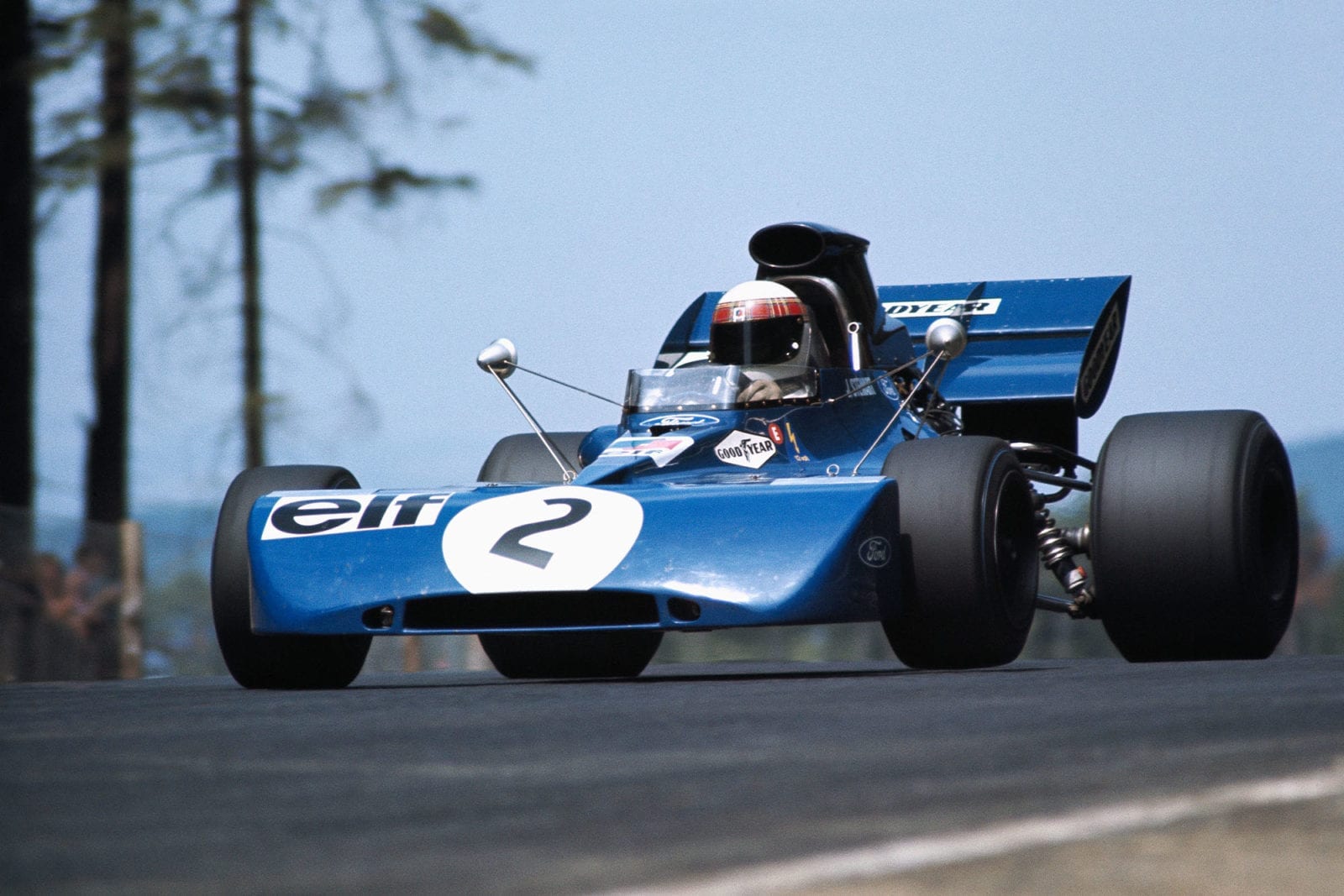
Jackie Stewart claimed his fifth win in seven races this season for Tyrrell
Motorsport Images
Tyrrell double again
Nurburgring, Germany, August 1st.
There was no doubt in my mind that the return of the German Grand Prix to the Nurburgring after its brief removal to the Hockenheim Motodrom was popular, for the movement and race fever was already evident when I arrived at the circuit the day before practice began. By the time race day arrived the Eifel mountains were like a human ant-hill, and though no official figures were given for the attendance the scene was reminiscent of the early post-war years and I have not seen crowds like it for ten or more years. A promise of superb weather for the weekend and the return of the Grand Prix to its only possible home seemed to arouse enthusiasm throughout Western Germany and the neighbouring European countries, so that the result was memorable; the only sad thing was that the race did not turn out quite as expected.
There was no lack of support for the first Grand Prix on the “new look” Nurburgring, for all the teams were entered, Ferrari, March, McLaren and BRM with three entries apiece, and Tyrrell, Surtees, Lotus and Brabham with two entries each. Matra were reduced to one entry, for the affair of the Giunti/Beltoise accident in the Argentine last winter had arisen again in FIA circles and Beltoise had been banned from driving for a further period of time, so that Amon was left on his own to defend the French colours. To complete the list there were the private entries of Frank Williams’ March 711 for Pescarolo, the Clarke-Mordaunt March 711 for Beuttler, Bonnier with a McLaren, and the 1970 Surtees TS7 “hire-car” that Dieter Quester was arranging to borrow, but the financial arrangements fell through at the last minute, causing Surtees to remark something about “If Quester drove like he talked he’d be a World Champion”.
Of the three-car teams Ferrari were undoubtedly the strongest on paper, with Ickx, Regazzoni and Andretti in the three 1971 Ferraris, with a 1970 car as spare. The BRM team had co-opted Elford into their ranks to drive the late and much lamented Rodriguez’ car, with Siffert leading the team and Ganley being the third member, while McLaren were reduced to the two entries of Hulme and Gethin due to a shortage of engines caused by the Cosworth factory being on holiday, so it was Oliver who was dropped. The STP-March team had Peterson, Galli and de Adamich in their cars. The situation is rapidly developing where one Tyrrell car is bad enough for the opposition but two cars are twice as bad, and if Tyrrell ever enters three cars there will be a lot of people who will feel like giving up. His two entries were, as usual, Stewart and Cevert, while Lotus had their usual mixed-double of Fittipaldi and Wisell, and Surtees and Stommelen were in the Edenbridge factory cars, while Hill and Schenken were in Tauranac’s Brabham cars.
The major changes to the machinery being used were confined to March and Lotus, for the STP-sponsored team had rebuilt 711/4, that Galli had driven at Silverstone with a Cosworth V8, and converted the back-end to take an Alfa Romeo V8 engine, while the Gold Leaf-sponsored team had built a new Type 72 to the latest D-specification, for Wisell to drive, this being R6, while his old car R3 had been refurbished and Charlton had taken it back to South Africa in place of Rob Walker’s R4, which had been the original choice. The minor changes involved the re-making (I cannot say re-designing) of bits that broke at the British Grand Prix, such as the coil mountings on the P160 BRMs, and the addition of proven parts such as a full-width nosepiece on the spare Tyrrell car, while new minor details included a full-width nosepiece on Schenken’s Brabham BT33/3, German Bilstein shock-absorbers on Peterson’s works March as well as a cold-air box on its Cosworth engine, some experimental drilled brake discs on Hulme’s McLaren, revised air-collector boxes for the Surtees cars, and a solitary CSI/GPDA regulation rear light on Bonnier’s old McLaren, which was almost a new McLaren as it had been rebuilt with the monocoque being re-skinned.
Qualifying
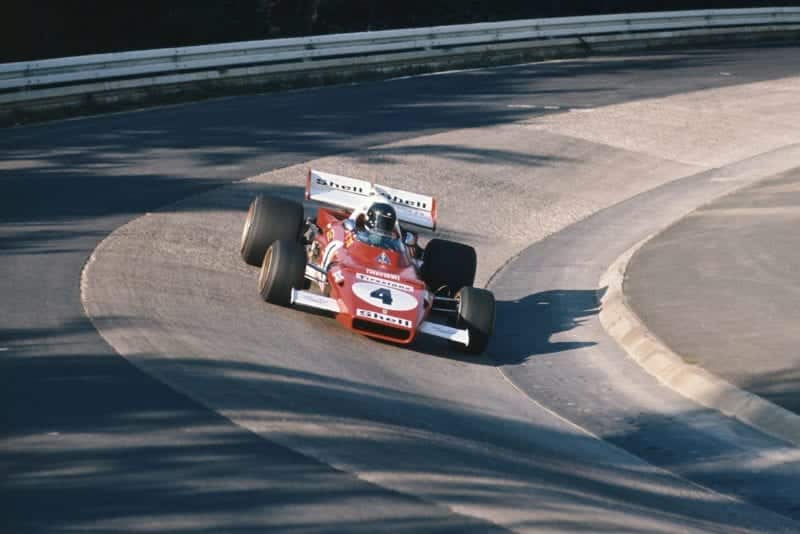
Ickx was second on the grid behind Stewart
Motorsport Images
Practice was arranged pretty fairly, with two sessions of one-and-a-half hours each on Friday and a two-hour session on Saturday. The first session started at midday on Friday with the Eifel mountains on their best behaviour, the sunshine bringing out large crowds very early in the proceedings, and everyone who had not taken part in the ADAC 1,000-kilometre race last May was keen to find out about the cleaned-up Nurburgring. Although the widening, smoothing out and resurfacing met with Stewart’s approval, it was soon evident that the Nurburgring was still one of the best challenges to Grand Prix car designers and builders, and to drivers, for speeds were higher everywhere and road-holding and suspension as well as bravery and skill were at a premium. Those teams that were not trying to stop the undersides of their cars scraping on the ground in the dips were trying to keep the wheels on the ground over the humps or trying to make their cars handle on the multitude of differing corners, both horizontal and vertical. More work was being done on shock-absorbers, springs, roll-bars, tyres and ride-heights than on engines or gearboxes, and those that were not trying to solve these problems were picking cars off the edges of the circuit or replacing broken engines.
When the last German GP was held at the Nurburgring, in 1969, it was over 14 laps—a distance of 319.69 kilometres—and lckx won with a Brabham in 1 hr. 49 min. 55.4 sec., he making fastest lap in 7 min. 43.8 sec. For some unaccountable reason that no-one would admit to, this year’s race was reduced to 12 laps, a mere 274 kilometres. (We must forget the “bad old days” of Ascari and Fangio when they raced for 22 laps of the Nurburgring to find out who was going to win the German GP, for I am told that that is not progressive thinking.) With two years’ advance in power and road-holding, to say nothing of the two years’ advance in the glory, the estimate of laps at 7 min. 20 sec. was reasonable enough, especially taking into account the widening, smoothing and resurfacing of the circuit, and in the first session Stewart took his Tyrrell 003 round in 7 min. 21.9 sec., to set a new standard. Just what some of the other drivers, engineers, designers, team managers, mechanics and helpers were doing is hard to appreciate when you look at the list of best laps recorded during the first practice session, while some of the slowest laps of which we never hear must have been remarkable. For some people there were good explanations, such as the fact that Wisell never left the pit area as his Lotus 72 was so new it was being finished off as practice began, so he confined himself to laps round the short pit loop and never set off round the full circuit.
Beuttler did not get far before he crashed his March 711 into an Armco barrier and Bonnier was presumably doing an official tour of inspection in his McLaren on behalf of the GPDA. Later Marko set off for a lap in this car but ran out of petrol! Stommelen blew up the engine in his Surtees car TS9/002 and Galli broke the Alfa Romeo engine in the March 711/4, while Pescarolo ended practice with his March monocoque bending in the middle and creasing the outer panels. Ganley’s P153 BRM broke its gear-change linkage but Siffert was recorded by the timekeepers at 7 min. 22.4 sec., a time that a lot of people doubted as he was the only driver to break 7 min. 30 sec. apart from Stewart. There was no practical reason why Stewart should be so much faster than everyone else, except that he was working hard for the people who pay him, as he always does, and the Tyrrell team are on such a winning streak at the moment that their air of efficiency and quiet calm is psychologically demoralising everyone into a state of depression that seems to make them stop trying, especially if they are trying to race with a Cosworth engine. There were five training cars standing by but none of them were used during this first practice session, these being the 1970 Tyrrell for Stewart, No. 4 of the 1970 Ferraris for the Maranello drivers, the first of the 1971 Matras for Amon, the latest P160 BRM for Siffert and the latest 1971 Surtees for Stommelen or the owner of the team.
In the late afternoon there was another hour-and-a-half of practice and needless to say Beuttler was missing, as was Galli, but Stommelen practised in the spare Surtees while another engine was installed in his regular car. Siffert’s car was also undergoing an engine change so he used the spare BRM, and Ganley was missing as his gear linkage was being repaired. Amon changed to the spare Matra-Simca V12 and Stewart went out in the old Tyrrell only to have the engine break. He returned on the pillion of a motorcycle and promptly went out in the 1971 car and set fastest time of the day with 7 min. 19.0 sec., which demoralised everyone even more. Regazzoni landed all wrong hi his Ferrari after aviating over a new hump at Plfanzgarten, the jump being caused by the previous bends having been made smoother, and the Ferrari damaged its right rear quarter; he returned to the paddock and went out in the spare Ferrari.
With Stewart getting below the estimated 7 min. 20 sec. it was not unreasonable to expect most of the reasonably good drivers to get below 7 min. 30 sec., but only three managed this during the afternoon. These were Ickx, as was expected, with 7 min. 22.9 sec., Regazzoni in the old car with 7 min. 27.6 sec., which keeps one’s sense of proportion straight, and Cevert with 7 min. 24.0 sec. in the Tyrrell 002. This last performance caused quite a flutter for it meant one or all of three things, either Cevert had one of the Stewart “special” engines, the Tyrrell car was outstanding on the Nurburgring, or the young Frenchman was developing into an ace-driver under the tuition of Stewart and Tyrrell. Your association with Grand Prix racing affected your choice of reason for this performance by Cevert and the only team that was not worrying was the Tyrrell team, they were very happy with their number two driver, while Cevert himself was overjoyed and well satisfied with his performance. Slower than the 7 min. 30 sec. mark were ex-World Champions, new rising stars, old hands and hopefuls.
At midday on Saturday there was a final two hours of practice for honour to be retrieved by those embarrassed by Cevert, for potential winners to try and challenge Stewart, and for those in mechanical trouble to try and get themselves sorted out. Stommelen was back in his normal car, Pescarolo’s March had been cleverly strengthened inside the monocoque, Stewart had another engine in his spare car, Regazzoni’s 1971 Ferrari had been repaired, as had Beuttler’s March and Ganley’s BRM, while Galli’s March and Siffert’s BRM were ready with new engines. In fact, the amount of work that mechanics had done in the paddock in rather poor conditions during Friday and during the night was quite phenomenal, and if the GPDA want something to turn their good intentions on it might be double pay for overtime by their mechanics and some better lighting and bench facilities in the paddock garages. After spending many millions of Deutschmarks on the circuit to appease the drivers it is pathetic to see their mechanics working in crude lock-up garages with a single 40-watt bulb in the ceiling, just as they did twenty years ago. The daily thrash round the Nurburgring got under way with quite a rush as people realised it was now or never and a number of drivers got well below the 7 min. 30 sec. time, and lckx joined Stewart in the “super-ace” category with a 7 min. 19.2 sec. lap, a mere two-tenths of a second away from Stewart’s pole-position time.
Cevert proved that his Friday performance was not a fluke by improving to 7 min. 23.4 sec. and Regazzoni beat him with 7 min. 22.7 sec., which seemed only right and proper in view of the time Ickx recorded. Siffert dispelled the Friday doubts with another good lap well below bogey time, and Hulme and Fittipaldi joined him in the elite class, while Schenken scraped in by two-tenths of a second, which was praiseworthy enough when you looked at some of the drivers who did not reach bogey time. The STP-March team were confident that Peterson was well in the elite category so were rather taken aback when the official practice results gave Peterson’s best lap as 7 min. 32.4 sec. The number one talker of the March concern soon went round the other teams and found three of them had recorded a similar mid-20-sec. time for Peterson, the Swede being one of the drivers who other teams keep a stopwatch on during practice, so armed with this information he attacked the organisation after practice and eventually a new time was issued for Peterson; 7 min. 26.5 sec., and everyone was happy.
Stewart had settled at 7 min. 22.0 sec. and before he could re-assert himself in the fastest time of day position rain clouds swept across the Eifel mountains and practice fizzled out very suddenly as the rain poured down. At one moment the pits were full of photographers photographing, Press pressing and hangers-on hanging on, and it was almost impossible for anyone to do any serious work. Within seconds the whole pit area was clear except for the racing cars and the mechanics and one or two enthusiastic followers of Grand Prix racing. To everyone’s amazement, not the least mine, Hulme went out in the pouring rain and did a full lap of the circuit and returned wet but laughing at all the open mouths that greeted his return as if he had taken leave of his senses. He said that his 7 min. 26 sec. lap in the dry with a bog-standard Cosworth V8 engine had put him in a good mood. Stewart, Schenken and Surtees all had a splash round the short pits loop, and Wisell skated back to the paddock on Firestone “slick” tyres. As practice ended under rainy skies Pescarolo’s March was being retrieved from out on the circuit where it had landed in a heap after yet another rear hub casting had broken.
Race
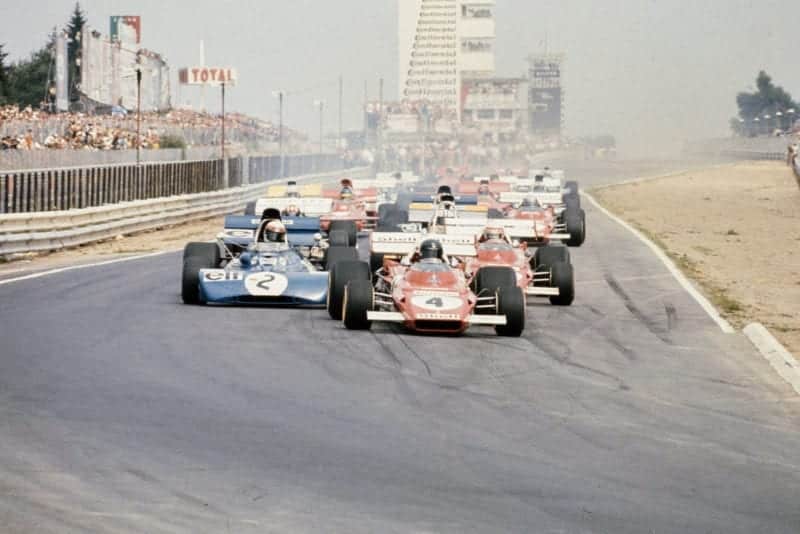
The 1971 German Grand Prix gets underway
Motorsport Images
The start of the German Grand Prix was due at 1 p.m. on Sunday and even early in the morning it seemed that most of the spectators had camped out overnight to be sure of a good vantage point, yet the traffic flowed in continuously until well after lunchtime and the Nurburgring was as full as it has ever been. The only difference was that this time the paying public could really see something for the safety improvements have benefited the spectators almost more than the competitors. The morning was fully occupied by races for Formula Vee and Super-vee, a rousing demonstration lap by Ford’s Transit Supervan. displays by dancing girls and a variety of race-followers both in and out of the paddock that reached an all-time high. The race rules said that no cars would be allowed through the tunnel that leads from the paddock to the pits later than ten minutes to one o’clock, and that a warm-up lap of the short pits loop would be made by everyone before lining up on the dummy-grid. When Hill’s Brabham BT34/1 was started up in the paddock there was a depressing shortage of fuel pressure, so a lot of the mechanical bits were torn apart to find the trouble and it was cured and reassembled in a mad rush to beat the paddock gate closing time.
When Pescarolo tried to leave the pits his engine would not run properly and it was suddenly realised that in the flap of rebuilding the rear suspension the engine had not had a new set of plugs fitted, so this was done in haste while everyone else left the pits to go to the start. As most of the drivers joined the circuit from the concrete pit lane they stopped on the tarmac and did a practice start, and for the spectators in that area it was liked a non-stop drag-race meeting as car after car took off in a cloud of tyre smoke. The modern 3-litre Grand Prix car presents an impressive sight as it accelerates away leaving 16-in. wide black lines on the tarmac. At the very last minute Pescarolo joined the happy throng on the grid, at which point Hill and Wisell were suddenly very unhappy for the Brabham’s throttle linkage had fallen apart and Wisell’s engine had developed a vapour lock in the fuel pump. Consequently only 20 cars roared away when the German flag was lowered, with Ickx beating Stewart to the first corner by a few feet.
The cars had been lined up in pairs, with Stewart on the right at the front, lckx alongside and Regazzoni and Siffert behind them, so once again the Scot was the only Cosworth-powered and Goodyear-shod runner in the forefront, which pleased his sponsors no end. As they rounded the South Curve and raced up the straight behind the pits the leading Ferrari had the blue nose of the Tyrrell almost touching its exhaust pipes and the little beady eyes of the Scottish driver had a very hard and determined look in them, for with only two-tenths of a second between him and Ickx on practice times he could not afford to hang about. Back on the grid a shrewd blow in a strategic place had cured Wisell’s lack of fuel pressure, and he joined the race as the tail-enders were still down at the South Curve. Poor Hill was not so fortunate for his trouble was due to a vital nut being left off during the last-minute panic in the paddock, and the leaders were over half a lap away before his throttle cable was refixed and he could start racing.
It was clear that Stewart was not going to stand any messing about from Ickx as he forced his Tyrrell into the lead on the North Turn before they were even out of sight of the pits. Although Hulme had made a good start from the third row, following the two Ferraris, he was passed by Siffert and Peterson during the opening lap. With the official lap record standing to Ickx from 1969 it was no surprise that Stewart’s standing lap at 7 min. 37.7 sec. was a new record, nor that his first flying lap was also a record, at 7 min. 29.9 sec. Stewart ended the first lap with a commanding lead over the Ferraris of Ickx and Regazzoni, who were followed by the BRM of Siffert, the March 711 of Peterson, Hulme’s McLaren and Andretti’s Ferrari, then came Cevert, Schenken, Fittipaldi and the rest, except for de Adamich’s March-Alfa Romeo which had already expired with fuel-injection trouble. Hulme was already in trouble with a leaking petrol bag tank, the petrol getting on his feet, and both Andretti and Cevert went past him on the second lap. With a clear road ahead Stewart was putting as much distance as he could between his Tyrrell and the Ferraris, and as Ickx swept up through the climbing right-hand turn at Wippermann he spun off the track, across the dirt safety area in a cloud of dust and clouted the Armco barrier with the back of the car. Regazzoni took avoiding action through the dust cloud and before he got himself sorted out he had an excursion off the track which let Siffert nip through into second place and caused the Ferrari to damage its exhaust system under the engine. A very disgruntled Ickx was getting out of his derelict Ferrari, the impact with the Armco not only putting a very large dent in the new steel wall, but bending the left rear suspension and top radius arm of the Ferrari, and wiping off the battery and all the ignition and charging-system that is mounted on the rear of the gearbox.
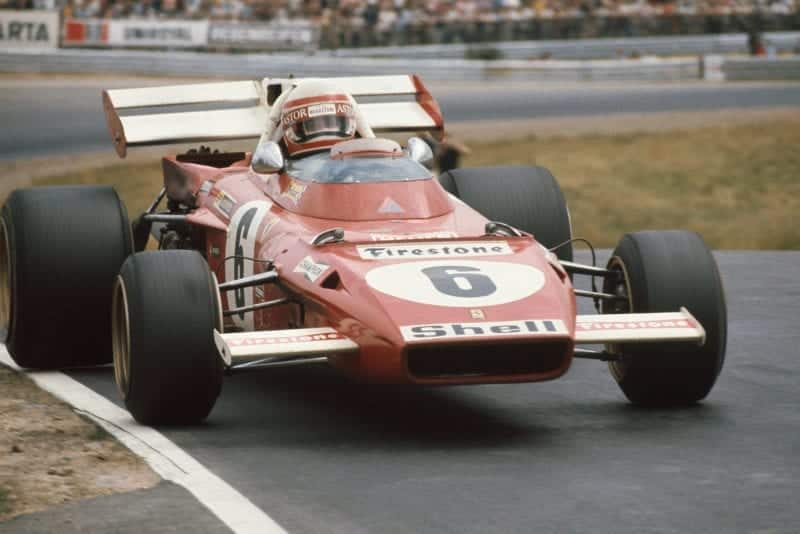
Clay Regazzoni managed to get his Ferrari into the final podium place
Motorsport Images
This little contretemps by the Ferrari team meant that Stewart ended lap 2 some 15 sec. ahead of Siffert’s BRM and once again all hope of a Grand Prix race was gone. Regazzoni’s Ferrari followed, then came Peterson’s March, followed by Andretti’s Ferrari and Cevert’s Tyrrell side-by-side, the young Frenchman getting ahead at the South Curve. The rest went by one after the other in the order Hulme, Fittipaldi, Schenken, Pescarolo, Stommelen, Gethin, Elford, Surtees, Ganley, Beuttler, Galli and Amon, the Matra driver really suffering as his V12 engine was popping and banging. A long way back came Wisell with Hill even further back and when it had all gone quiet at the pits de Adamich arrived to complete his first lap. Amon’s practice had gone from had to worse and all the good Matra engines were used up, so that he started the race with a car cobbled-up from the front half of MS120B/06, a rather tired old engine, and the rear end off MS120B/04 with the earlier rear suspension layout. Altogether he would have rather have gone home than try to race. Going along the straight behind the pits Ganley suddenly found oil pouring into the cockpit of his BRM and switched off in a cloud of smoke before the whole engine broke, so with the race hardly begun we were down to twenty runners of which Hulme and Amon had little hopes of finishing, and de Adamich was too far back to get anywhere even had his Alfa Romeo engine been made to run properly.
The end of lap 3 saw Stewart with so much lead that he was passing by the back of the pits as Siffert arrived at the front of the pits, and Hulme had dropped out of the running as the fuel leak had become impossible. He drew into the pits, drip trays were put under the leaking McLaren and he removed his petrol-soaked shoes and socks and sat and watched the race. In the meantime Beuttler had got a flat right front tyre on his March as he passed the back of the pits and rather than try and drive a full lap on the flat tyre he turned off into the loop at the North Curve and came back to the pits, entailing immediate disqualification. It was unfortunate but there was no other way for he would not have got far on the flat tyre, so “now there were only seventeen little Grand Prix drivers” for de Adamich had given up. Almost without being noticed Cevert had overtaken Peterson and was in fourth place on lap 3, and on lap 4 when Stewart lapped in a new record time of 7 min. 27.2 sec., Cevert did 7 min. 27.9 sec. At the same time Siffert’s BRM engine began to misfire which caused him to drop back so that the BRM, Regazzoni’s Ferrari and Cevert’s Tyrrell ended the lap in close company, and during lap 5 both the Ferrari and the Tyrrell passed the ailing BRM.
This left Stewart with 33 sec. lead, aided by a lap in 7 min. 25.5 sec. and Siffert passed the pits in fourth place pointing at his front suspension. From the mid-field Pescarolo stopped at the pits as his March seemed to be falling apart again, and a short trip round the pits loop confirmed his feelings for the front suspension was bent and the rear suspension was coming away from the chassis. After a mere six laps the race was halfway through and Stewart’s lap record run was down to 7 min. 23.6 sec., while Cevert was trying hard to get past Regazzoni’s Ferrari which was sounding bad and was 500 r.p.m. down on maximum due to the damaged exhaust system. Siffert took the short loop back into the pits as his engine died on him with a defunct coil, entailing immediate disqualification, which he did not mind as his right front lower wishbone member was coming adrift from the chassis. Amon was long overdue and arrived late at the pits with signs of a private accident with a barrier on the right-hand side of the car, so “now there were only thirteen little drivers left,” for Gethin had also gone, having spun gently off the track on the left-hand bend at Metzgefeld, just in front of Surtees and Elford, the McLaren sustaining a bent rear suspension. To add to the carnage Galli was black-flagged as the March-Alfa Romeo’s rear aerofoil was falling off, a trouble that Peterson had experienced in practice, so he drew into the pits after seven laps to have it removed, and Fittipaldi was already there as his Lotus was losing oil and had broken its front anti-roll bar. Cevert had got in front of Regazzoni but the Ferrari driver was doing his best to keep up, and just had not got the speed of the Tyrrell along the main straight. Stewart covered lap 8 in 7 min. 22.9 sec. and Peterson dashed into the pits to have a damaged fibre-glass cover removed from one of the side-mounted radiators of his March 711 and this dropped him from fourth place to fifth behind Andretti, but safely ahead of Schenken who was sixth.
Galli returned to the pits with broken engine mountings on the March-Alfa Romeo, probably the reason for the aerofoil falling off, and as nothing could be done he limped away to try to finish. Fittipaldi also came back to the pits, this time for good as all his oil had leaked away from a split tank, so this left eleven fairly healthy runners and one sick one, and by proper Grand Prix standards the race was barely under way, but by mini-Grand Prix standards it was fortunately nearly over. The ninth lap saw Regazzoni driving really hard to stay with Cevert, but on the next lap the Tyrrell number two driver did an inspired 7 min. 20.1 sec. lap, which even Stewart did not improve upon, having done 7 min. 21.8 sec. on that lap. As Elford went by the back of the pits his BRM engine stopped as the ignition coil failed, as had Siffert’s, and while the leaders were ending the race he got another coil from the pits and fitted it to the engine and got going again, finding that the engine went better than it had done since the start. Stommelen made a quick stop at the pits to say that his Surtees felt a bit odd, but as nothing was visibly wrong he went on. As Stewart was a comfortable 40 sec. ahead of his team-mate he was able to take things easy by his standards, and went round in 7 min. 20.8 sec., not knowing that Cevert was holding the lap record. The number two Tyrrell driver could not relax for the swarthy Swiss Ferrari driver had not given up the chase and was hounding the pretty young French lad unmercifully, though without hope of regaining second place unless Cevert made a mistake, which was unlikely as he has the ability to concentrate to the full even when under pressure.
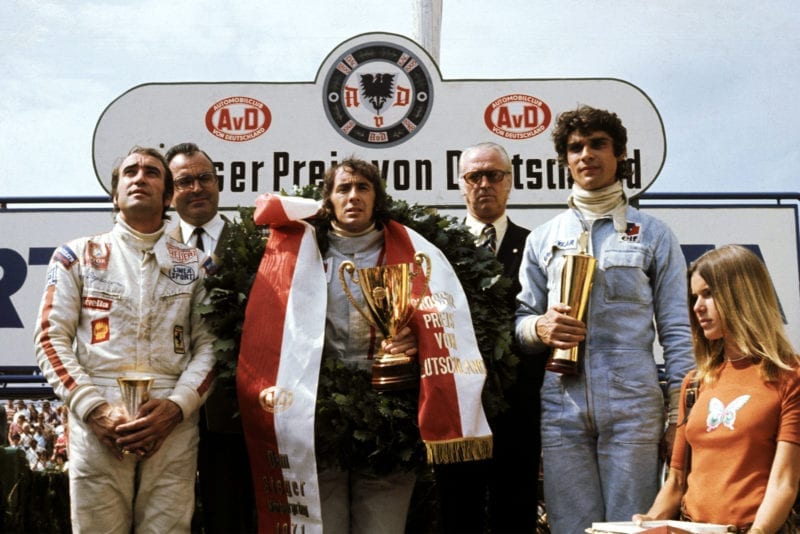
Jackie Stewart takes the plaudits after another impressive victory
Motorsport Images
Stewart cruised home to another undisputed victory to the joy of Tyrrell, Gardner, Elf, Ford and Goodyear to say nothing of J. Stewart Incorporated and Cevert finished a strong second to the absolute joy of Monsieur Francois Cevert himself and Regazzoni was a hardworking third. Then came a rather uninspired Andretti, an ever-improving Peterson and Schenken, the Australian having a trouble-free run this time. Surtees followed with the two late starters WiseII and Hill behind him, and the Brabham driver just failed to make up his handicap on the Swede. It had been a short and sweet German Grand Prix run in perfect conditions and everyone seemed well satisfied to see it back on the circuit where it rightfully belongs, for the Nurburgring is still the Nurburgring and one of the finest Grand Prix circuits ever built.—D.S.J.
